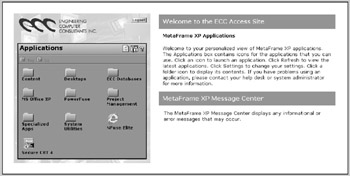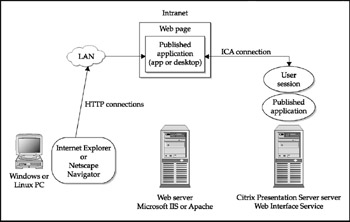CITRIX WEB INTERFACE
| | ||
| | ||
| | ||
Web Interface for Citrix (formerly called NFuse Classic) evolved from the Citrix ALE technology used to deploy applications to Web browser clients . Web Interface combines the Web-publishing features of the ALE client with many of the management features of Program Neighborhood, including the ability to dynamically publish a new application to a logged-on user . Users just click the Refresh button on their browser, and the new application icon appears on the desktop within the browser. Web Interface comes standard with a default Web page setup that provides an administrator with a very simple and quick setup of the Web Interface. The Web page can be customized with any standard HTML tool. An example of a default Web Interface session is shown next :

Web Interface is a three- tier solution that includes a Citrix server component, a Web server component, and a Citrix client component with the Web browser. Web Interface doesn't replace the Citrix client; rather, it interoperates with it to provide the capabilities native to the operating system platform. Web Interface extends the publishing capabilities of the ALE client by providing a means to integrate applications from other sources, such as Presentation Server for UNIX, and by allowing applications and access to be customized by users. Figure 7-2 shows the Web Interface application publishing architecture.

Figure 7-2: The Web Interface application publishing architecture
Web Interface supports the features of Program Neighborhood within the context of the browser. Instead of pushing an application icon to a PC's desktop using the Seamless Windows feature, the icon would appear on the desktop within the browser.
A subtle but important advance offered by Web Interface is that the Web components can be configured to resolve application names to IP addresses, eliminating the need for the Citrix client to use the UDP-based ICA browser. UDP access can then be eliminated from the firewall, thus enhancing overall security. Further, by utilizing Citrix Secure Gateway Server or Citrix Access Gateway with Web Interface (discussed in Chapters 2, 8, and 16), no outside firewall ports have to be open at all, and the Presentation Server servers can be placed securely inside the firewall.
Finally, Web Interface offers both client and server scripting capabilities to run external programs, customize the user session, or integrate with other Web technologies such as COM, Java Server Pages, or Active Server Pages.
Three components are required to run Citrix Web Interface: a Presentation Server server running the Web Interface Service, a supported Web server (Microsoft IIS or Apache), and a Citrix client with a supported Web browser.
Web Interface, along with Citrix Access Gateway, which further automates the integration of Presentation Server and non-Presentation Server Access, will be covered in depth in Chapter 16.
EAN: 2147483647
Pages: 137